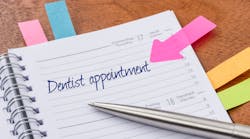The end of the calendar year is often a busy time at dental offices. Patients rush in to get the most out of their insurance benefits before they restart in January. I’ll never forget one year when a patient insisted on getting his two insurance-covered hygiene visits in the last week of the year. While I was excited he wanted to maximize his benefits, piggybacking the two visits wasn’t exactly benefiting his oral health the way he hoped.
But how often should you see your hygienist? That all depends on your oral health. (And no, you don’t get to decide what that means.) Dental lore says that the twice-a-year rule actually came from an Ipana toothpaste commercial, not science. Then insurance companies picked it up, and somehow it became gospel that you should see your dental hygienist every six months. That interval may be perfect for some people, but many others might need a shorter interval between visits—or even a longer one.
Determining your perfect interval weighs a lot of factors. And insurance companies aren’t doing anyone any favors by making a hard-and-fast rule that twice a year is best for everyone. Your dental team should look at your specific risk factors and recommend an appropriate interval based on their findings.
More Dear Patients:
I'm sorry I nagged you about flossing
Your unhealthy mouth could kill you
The American Dental Association (ADA) has established a cavity risk form that places patients in a low, moderate, or high-risk category based on their lifestyle, health, and clinical condition of their mouth. And the American Academy of Periodontology has established a similar grading scale to assess the health of patients' gums. These tools weigh in previous dental treatment, medications, age, medical history, home care, dental needs, and more. Along with their experience and input from you, your clinician can determine the right interval for your preventive care.
And remember: just because you’ve always had a certain hygiene schedule doesn’t make it the right one forever. Individualized care that takes your health and wellness into consideration is what will keep you healthy and perhaps out of the dental chair as often. Talk to your dental professional about what the perfect interval is for you.
Low risk (once a year)
This is the gloriously boring patient who ends up in my chair once in a blue moon. It could be they won the genetic lottery or have fastidious home care and healthy living, but somehow these patients have gotten into adulthood without a history of cavities or gum disease. These unicorn patients can safely come in once a year for their preventive maintenance.
Moderate risk (every 6 months)
The majority of patients sit in the moderate risk zone. If you have had bleeding gums or a cavity in the last five years, you should be seen every six months at a minimum. It doesn’t take long for cavities or gum disease to rebound, and if we can catch these issues in their early stage, we can avoid extra treatment. Age plays a role in determining risk factors, too. I often see college kids come back on break with a mouthful of cavities because the unlimited soda and bathroom down the hall made the perfect storm for decay. Generally, school-aged patients' (25 and under) status can change fast, so it’s best to keep them at a minimum of every six months.
Another factor that will put you at moderate risk is the quality of your saliva. This can be affected by medications, habits, overall health, and maybe genetics.
High risk (every 3 to 4 months)
High-risk patients are those with active disease, those who seem to bounce from healthy one visit to cavities or bleeding the next, or who have a history of periodontal disease. With the extra one or two visits a year, the dental team can stay on top of any issues and help your mouth achieve a healthier oral microbiome. Biofilm is tough to rein back in once it gets out of control. So these more frequent visits could be exactly what these patients need to find balance.
Extreme risk (monthly)
These are the patients who cause us to lose sleep at night. Each time they come in, there are tons of cavities, or we just look at their gums wrong, and they bleed. While this typically isn’t a long-term schedule, some patients need that jump-start of a monthly biofilm disruption to get their mouth on a path toward health. This might involve what many call a “deep cleaning” or advanced instrumentation while the patient is numb so all the nooks and crannies get attention. This also affords us more time to go over home care techniques to set patients up for success.







